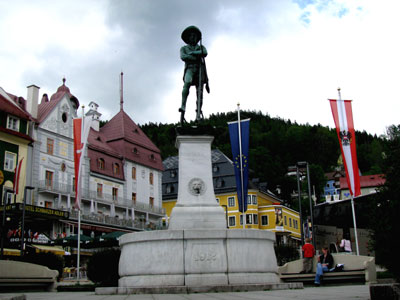My first three days in Austria had already been action-packed, full of hiking excursions and culinary delights. My next adventure was going to be a full-day driving tour with my friend Gary, who had also grown up in Austria, but, like me, had emigrated to Canada more than 40 years ago.
Gary’s native region is Upper Styria, a mountainous and heavily wooded part of my Austrian home province. He came to pick me up in his rental car in my home town of Weiz and we drove past the rolling hills of Eastern Styria through the picturesque villages of Anger and Birkfeld. Driving further up into the mountainous country to stop at the mountain pass of Alpl from where we had a gorgeous view of the high mountain regions of Upper Styria.

Mountain panorama of Northern Styria
On our way down from the mountain pass we drove down into the valley which hosts one of the region’s most popular tourist destinations: Peter Rosegger’s “Waldheimatschule”, a rural school building that was attended by one of Austria’s most famous poets of the 19th and early 20th century, Peter Rosegger. He was almost awarded the Nobel Prize in 1913 and to this day remains a popular local hero.

The Waldheimatschule, Peter Rosegger’s school
Continuing on our way into the Mürz River Valley we turned right onto the highway that connects Upper Styria with Vienna and drove towards the Semmering, a mountain pass at the border of Styria and Lower Austria. This mountain is most famous for the Semmering Railway that was completed in 1854 and connects Gloggnitz in Lower Austria with the town of Mürzzuschlag in Styria.

Beautiful church on the Semmering mountain
The Semmering Railway is in effect the first true mountain railway in the world, and it took six years to construct it. 14 tunnels and 16 viaducts, some of them two stories high, and more than 100 curved stone bridges overcome the challenging mountain terrain, and to this day, railway enthusiasts choose to travel on this still active route. The trains have to deal with an altitude difference of 460 m and a steepness of up to 2.5%. The extreme turning radii and gradients require special locomotives that could handle the challenge. The uniqueness of this mountain railroad was recognized with a UNESCO World Heritage site designation in 1998.

Rustic wooden architecture on the Semmering
The construction of the railway made the entire Semmering region a popular tourist destination. Numerous large hotels and villas were built in the second half of the 19th century, and even members of the Austro-Hungarian nobility enjoyed the healthy climate of this high-altitude spa town. Well-known Austrian artists and writers of the era also spent their vacations here.

The impressive Hotel Panhans
The most stunning example illustrating the heydays of the Semmering Region is the Hotel Panhans, a historic grand hotel dating back to 1888. After an expansion in 1913, the Panhans was considered one of the largest hotels in Europe with more than 400 rooms and offered luxurious amenities to its high-calibre guests. Prior to the collapse of the Austrian monarchy in 1918, celebrity guests included writers, painters and architects such as Peter Altenberg, Gerhard Hauptmann, Oskar Kokoschka, Arthur Schnitzler and Stefan Zweig. After the first World War famous guests included the likes of Josephine Baker, Jan Kiepura, and Maria Jeritza.

Entrance to the swanky Hotel Panhans
Today, the region is also a popular winter sport destination. World Cup ski races are held regularly on the adjacent Hirschenkogel mountain. Bikepark Semmering is a mountain biking park and the ski lifts are available to off-road bikers from June to October. The Semmering region is enjoying strong tourism growth for both summer and winter tourism.

Beautiful house in Neuberg an der Mürz
Having explored this historic spa town we turned around and drove back towards Mürzzuschlag. From this local district town we headed north into the Mürz River Valley, a deeply cut mountain valley, where we stopped in the village of Neuberg an der Mürz. This little town features a large Cistercian abbey from 1327. The Erzherzog-Johann-Kreuz (Archduke Johann Cross) has been adorning a rock wall above the village since the 1880s.

The Erzherzog-Johann-Kreuz

